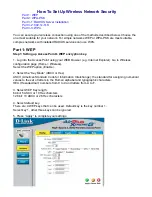
Node:
A network junction or connection point, typically a computer or
workstation.
Packet:
A unit of data routed between an origin and a destination in a network.
PLCP:
Physical layer convergence protocol
PPDU:
PLCP protocol data unit
Preamble Type:
During transmission, the PSDU shall be appended to a PLCP
preamble and header to create the PPDU. Two different preambles and
headers are defined as the mandatory supported long preamble and header
which interoperates with the current 1 and 2 Mbit/s DSSS specification as
described in IEEE Std 802.11-1999, and an optional short preamble and header.
At the receiver, the PLCP preamble and header are processed to aid in
demodulation and delivery of the PSDU. The optional short preamble and
header is intended for application where maximum throughput is desired and
interoperability with legacy and non-short-preamble capable equipment is not
consideration. That is, it is expected to be used only in networks of like
equipment that can all handle the optional mode. (IEEE 802.11b standard)
PSDU:
PLCP service data unit
Roaming:
A LAN mobile user moves around an ESS and enjoys a continuous
connection to an Infrastructure network.
RTS: R
equest
T
o
S
end. An RS-232 signal sent from the transmitting station to
the receiving station requesting permission to transmit.
RTS Threshold:
Transmitters contending for the medium may not be aware of
each other. RTS/CTS mechanism can solve this “Hidden Node Problem”. If the
packet size is smaller than the preset RTS Threshold size, the RTS/CTS
mechanism will NOT be enabled.
SSID:
Service Set Identifier, which is a unique name shared among all clients
and nodes in a wireless network. The SSID must be identical for each clients
and nodes in the wireless network.
Subnet Mask:
The method used for splitting IP networks into a series of
sub-groups, or subnets. The mask is a binary pattern that is matched up with
the IP address to turn part of the host ID address field into a field for subnets.
TCP/IP:
Transmission Control Protocol/ Internet Protocol. The basic
communication language or protocol of the Internet. It can also be used as a
communications protocol in a private network, i.e. intranet or internet. When set
up with direct access to the Internet, computer is provided with a copy of the
TCP/IP program just as every other computer that user may send messages to
or get information from also has a copy of TCP/IP.
75
Summary of Contents for 54MBPS WIRELESS LAN POCKET ACCESS POINT
Page 1: ...54Mbps Wireless LAN Pocket Access Point USER MANUAL...
Page 23: ...Now the main menu screen is popup 20...
Page 41: ...PPPoE with a fixed IP address 38...
Page 42: ...PPTP 39...




































